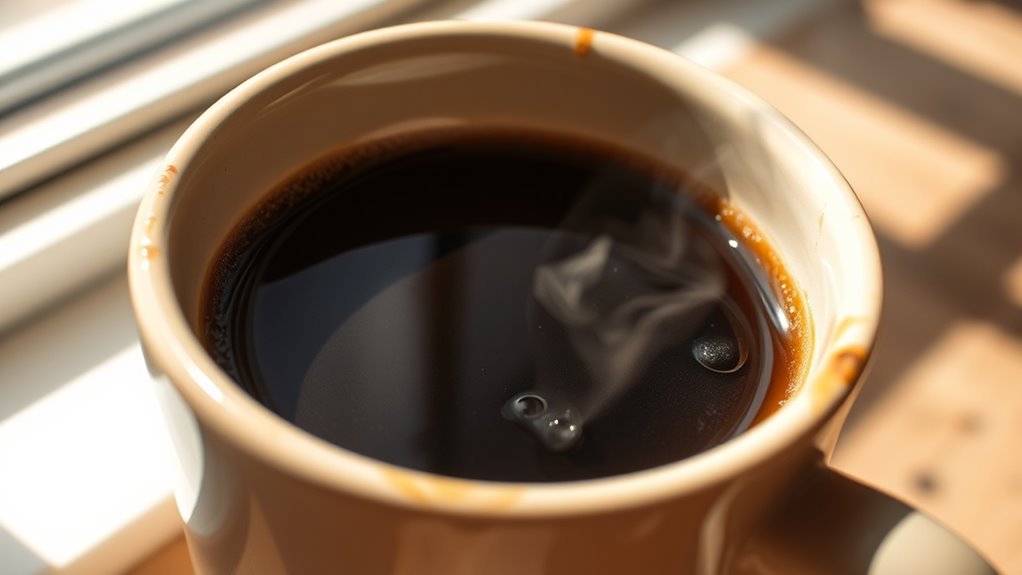How Long Can Coffee Sit Out at Room Temperature
Brewed coffee is best enjoyed fresh, but if left at room temperature, it can sit out for four to eight hours. After that time, flavor degradation starts, and there’s an increased risk of bacteria growth. It’s important to consume your coffee soon after brewing to preserve its rich taste and aroma. If you’re curious about effective storage methods and reheating techniques to maintain your coffee’s quality, there’s more valuable information to explore.
Understanding Coffee Freshness
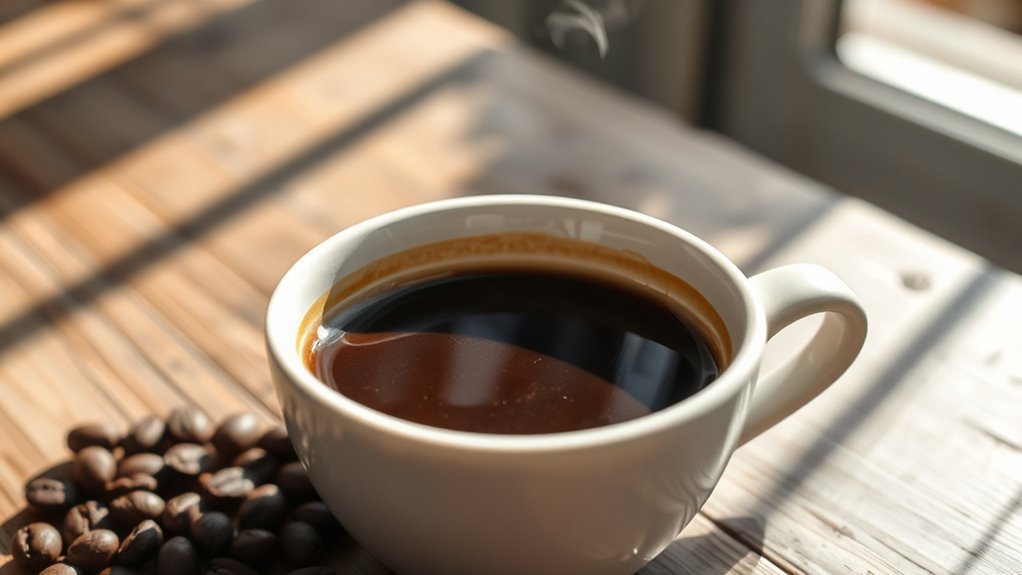
When it comes to coffee, freshness is essential for achieving that ideal flavor profile you crave. Coffee aging affects its taste, aroma, and overall quality. To maintain freshness, you should pay attention to several indicators. The roast date is a significant freshness indicator; ideally, you want to consume coffee within weeks of roasting. Additionally, look for signs like loss of aroma or dullness in flavor, which indicate that your coffee’s freshness is waning. Proper storage can slow down the aging process, but once exposed to air, moisture, and light, coffee deteriorates rapidly. Understanding these factors empowers you to enjoy coffee at its peak, ensuring each cup delivers the freedom and pleasure associated with a truly fresh brew.
The Effects of Time on Coffee Flavor
Although you might not think about it, the time coffee spends sitting out greatly impacts its flavor. When coffee is exposed to air, oxidation occurs, initiating a chemical reaction that leads to flavor degradation. This process begins almost immediately, causing the intricate notes and aromas you love to diminish. The longer coffee sits at room temperature, the more pronounced these changes become. Within just a few hours, you may notice a shift from vibrant to flat tastes, often losing the original character entirely. If you value the freedom to enjoy your coffee at its best, consider consuming it soon after brewing. By doing so, you can savor the rich flavors and aromas that oxidation threatens to erase.
Safety Concerns With Sitting Coffee
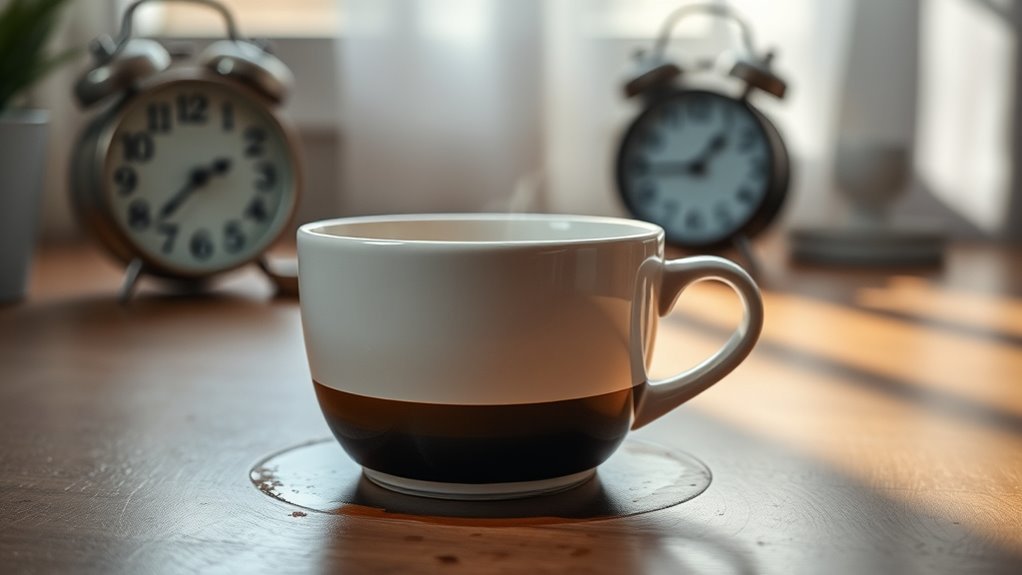
While you might enjoy that cup of coffee sitting on your counter, it’s important to reflect on the safety implications of leaving it out for extended periods. Stagnant coffee can become a breeding ground for bacteria, posing health risks.
| Time Left Out | Bacterial Growth Risk | Flavor Degradation | Safety Concern |
|---|---|---|---|
| 1 Hour | Low | Minimal | Low |
| 2-4 Hours | Moderate | Noticeable | Moderate |
| 4-8 Hours | High | Significant | High |
| 8+ Hours | Very High | Unpalatable | Very High |
Understanding these factors can empower your choices, ensuring you enjoy your coffee safely while avoiding harmful consequences.
How Long Can Brewed Coffee Sit Out?
Leaving brewed coffee out for too long not only raises safety concerns but also affects its quality considerably. After about 30 minutes, brewed coffee begins to undergo coffee oxidation, which can lead to noticeable flavor degradation. The complex flavors you enjoy diminish as the coffee interacts with air, causing it to taste stale and flat. Ideally, you should consume brewed coffee within one to two hours for prime taste. Beyond that, the acidity can increase, making it less palatable. If you’re aiming for the best experience, consider pouring any leftover coffee into a thermos to maintain its temperature and flavor. Ultimately, savoring coffee fresh is key to enjoying its rich complexity.
Factors Influencing Coffee Shelf Life
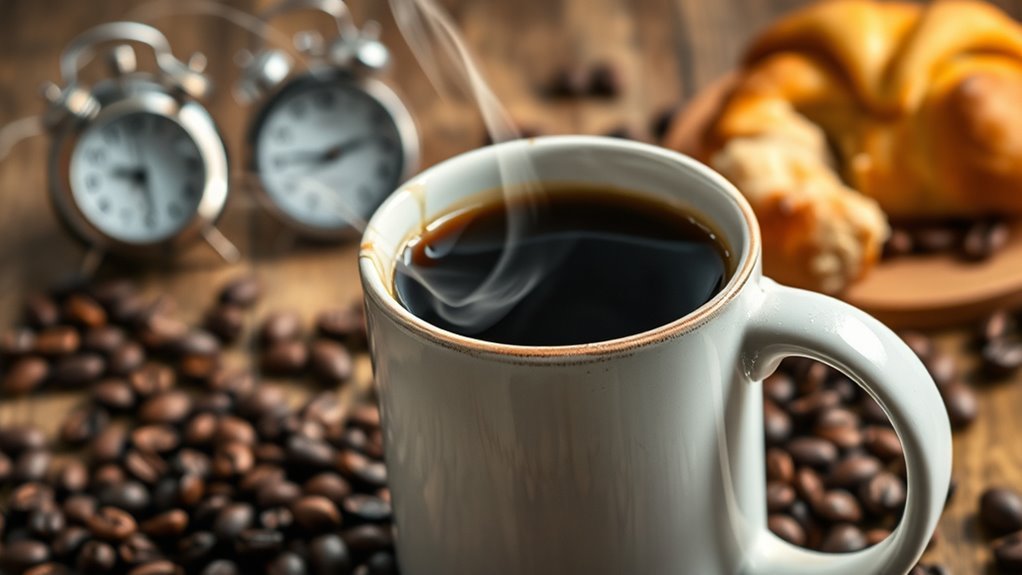
When considering how long coffee lasts, the brew method you choose plays a vital role. Different techniques extract flavors and compounds at varying rates, which can affect freshness. Additionally, environmental conditions, such as temperature and exposure to light, greatly influence how quickly coffee deteriorates.
Brew Method Impact
The brew method you choose can greatly influence how long your coffee stays fresh and palatable. Different techniques affect coffee extraction and, consequently, shelf life. Here are some key factors to evaluate:
- Brewing Temperature: Higher temperatures can lead to quicker oxidation, reducing freshness.
- Extraction Time: Methods like French press take longer, potentially enhancing flavors but also increasing spoilage risk.
- Coffee Grind Size: Finer grounds extract faster, which can lead to quicker degradation when left out.
- Brewing Equipment: Devices like vacuum brewers minimize oxygen exposure, helping maintain freshness longer.
Environmental Conditions Effects
Brew methods set the stage for coffee’s flavor, but environmental conditions play a significant role in determining how long that coffee remains enjoyable. Temperature variations can accelerate the degradation of coffee’s taste and aroma. Ideally, coffee should be kept at a stable room temperature, as fluctuations can lead to a rapid loss of flavor compounds. Similarly, humidity levels impact coffee’s shelf life; high humidity can cause the coffee to absorb moisture, leading to a stale or sour taste. On the other hand, low humidity may result in dry, brittle coffee. To maximize your coffee experience, consider storing it in a cool, dry place, away from direct sunlight, ensuring you savor every sip for as long as possible.
Tips for Storing Coffee Properly
To maintain your coffee’s freshness, choosing the right storage container is essential. You should also be mindful of the temperature and make certain that your coffee isn’t exposed to light, which can degrade its quality. Following these guidelines can greatly prolong the shelf life and flavor of your coffee.
Ideal Storage Containers
Choosing the right storage container for your coffee is essential to maintaining its freshness and flavor. Here are some ideal options:
- Airtight Containers: These prevent air exposure, which can lead to oxidation and staleness.
- Opaque Glass Jars: Light can degrade coffee quality; choose dark or frosted glass to block out UV rays.
- Vacuum-Sealed Bags: For those who buy in bulk, these bags minimize air and moisture, extending shelf life.
- Ceramic Canisters: With tight-fitting lids, these canisters offer an attractive and effective way to store coffee away from light and moisture.
Optimal Temperature Guidelines
Storing coffee properly goes beyond just selecting the right container; temperature plays a significant role in preserving its flavor and aroma. The ideal brewing temperature for coffee typically ranges from 195°F to 205°F (90°C to 96°C). This range allows for peak extraction of flavors. Once brewed, coffee should be consumed or kept at a proper serving temperature of around 130°F to 160°F (54°C to 71°C) for the best tasting experience. Avoid leaving your coffee at room temperature for extended periods, as this can lead to a decline in taste and freshness. Instead, consider using insulated containers to maintain that perfect warmth without compromising quality. Remember, temperature management is key to enjoying your coffee to its fullest.
Avoiding Light Exposure
While you might not think about light exposure when it comes to coffee, it can greatly impact the quality of your brew. Light degradation can diminish the flavor and aroma of your coffee, making proper storage crucial for flavor preservation. Here are some tips to safeguard your beans:
- Use an opaque container: Choose a dark-colored or opaque storage option to block out light.
- Store in a cool, dark place: Keep your coffee away from windows and direct sunlight.
- Avoid clear glass jars: They may look stylish but let in light that can harm your coffee.
- Seal tightly: Verify containers are airtight to minimize exposure to light and air.
Signs Your Coffee Has Gone Bad
Sometimes, it can be tricky to tell when your coffee has gone bad. One clear sign is a sour taste; if your brew tastes tangy or off, it’s likely past its prime. Additionally, pay attention to its aroma. A rancid aroma can indicate that the oils in the coffee have oxidized, resulting in unpleasant flavors. If your coffee smells stale or has a strange, musty scent, it’s time to toss it out. Other indicators include a change in color or an unusual texture. Trust your senses—if it doesn’t smell or taste right, it’s probably best to avoid drinking it. Quality coffee enhances your experience, so don’t compromise on freshness.
Best Practices for Reheating Coffee
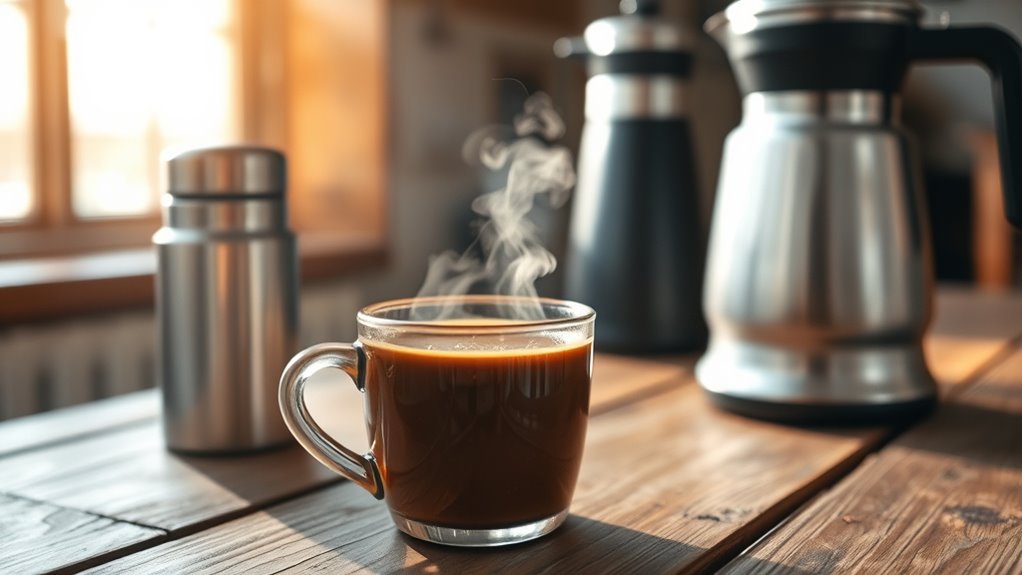
If you find yourself with leftover coffee, it’s vital to reheat it properly to maintain as much flavor as possible. Here are some effective reheating techniques for flavor preservation:
- Microwave: Use short intervals (15-30 seconds) and stir in between to guarantee even heating.
- Stovetop: Heat coffee gently in a saucepan over low heat, stirring frequently to avoid scorching.
- Coffee Maker: Pour your coffee back into the machine for a quick rebrew, which can enhance flavor.
- French Press: Add a small amount of fresh hot water to your coffee, then stir to rejuvenate the taste before serving.
Frequently Asked Questions
Can I Drink Coffee That Was Left Out Overnight?
You might be surprised to know that over 50% of coffee drinkers often leave their brew out, not realizing the potential coffee safety issues. If you’re considering drinking coffee left out overnight, think again; the overnight consequences can include bacterial growth. While it may not make you ill right away, the flavor and aroma will likely degrade. For a better experience, it’s best to brew a fresh cup instead.
Does the Type of Coffee Affect How Long It Lasts?
Yes, the type of coffee affects how long it lasts regarding freshness. For instance, brewed coffee made from high-quality beans and proper brewing techniques tends to maintain flavor longer than lower-quality or instant varieties. Factors like grind size and brewing method also play a role. While your coffee might still be safe to drink after a while, its taste and aroma can diminish considerably, impacting your experience.
How Does the Brewing Method Impact Coffee Shelf Life?
When it comes to coffee, think of brewing methods as different highways to flavor. Each method influences freshness factors like oxidation and extraction. For instance, a French press might yield a robust cup, but it can lose freshness faster than a cold brew, which minimizes exposure to air. Your choice of brewing method, consequently, plays a pivotal role in how long that delightful brew retains its quality, impacting your overall coffee experience.
Can I Add Milk to Coffee Left Out Overnight?
You shouldn’t add milk to coffee that’s been left out overnight. Milk spoilage can occur rapidly at room temperature, leading to potential foodborne illnesses. The combination of coffee and milk creates an environment where bacteria thrive. If you want to enjoy your coffee with milk, make sure it’s freshly brewed and consumed within a safe time frame. Prioritizing safety means you can enjoy your coffee without worrying about health risks.
Is It Safe to Reheat Coffee Multiple Times?
They say, “A stitch in time saves nine.” When it comes to reheating coffee, you can do it, but it’s best to limit how often. Reheating methods like the microwave or stovetop can alter your coffee’s flavor, often making it bitter or stale. Each time you reheat, you risk diminishing its quality. So, if you’re craving that perfect cup, try to enjoy it fresh rather than repeatedly warming it up.
